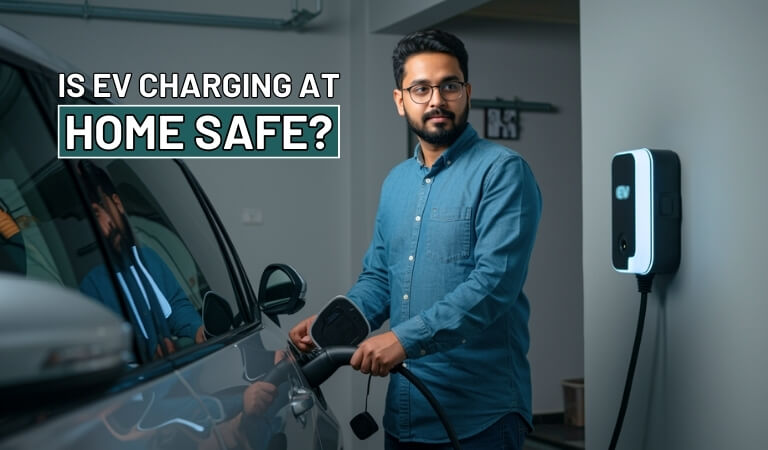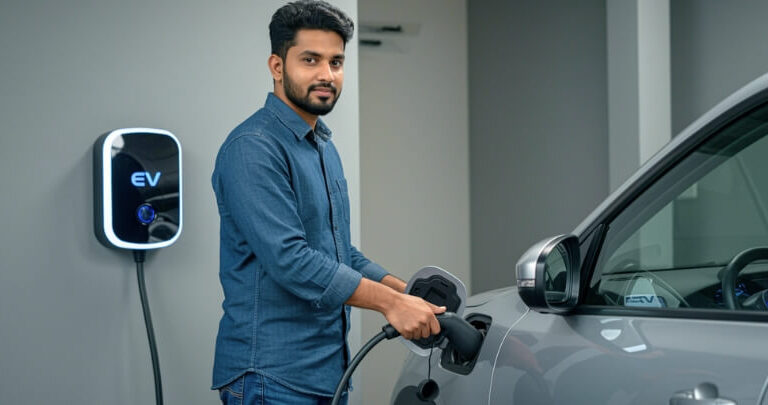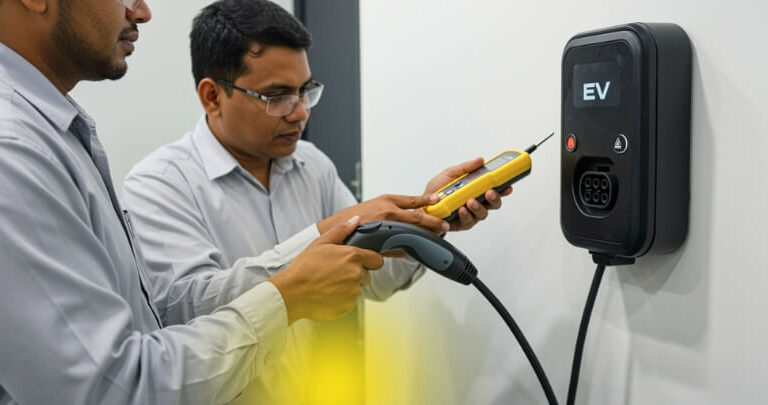Charging your electric vehicle at home sounds simple—but is it actually safe to do so without expert help? One of the main advantages of owning an EV is the convenience of charging it at home. However, many people wonder, “Is EV charging at home safe?”
Yes, EV charging at home is safe when done correctly. Using a certified charger, installing a dedicated charging station, and following safety guidelines are key to safe home charging. Avoiding circuit overloads and regularly inspecting electrical equipment will also minimize potential risks, like fires and electric shocks.
Throughout the rest of this article, we’ll provide detailed instructions for charging your EV at home in a safe way to avoid accidents. So stay with us.
Is EV Charging at Home Safe? Here’s What You Need to Know
Yes, EV charging at home is safe if you follow the right steps. It’s important to set things up properly and not rush. Using the right charger and being careful can help you avoid problems. Would you like to learn more about how to do it safely? See below for more information.

Use the Right Charger
Always use the charger that comes with your electric car or one approved by the car brand. These chargers are made to be safe and work best with your car. Never use random chargers or extension cords, even if they fit. They can get hot and may cause a fire. Some may also not charge your car correctly. Stick with trusted chargers to stay safe.
Install a Charging Station
It’s smart to set up a home charging station, also called a wall charger. These chargers are safer and faster than using a regular plug. Always call a trained electrician to install it for you. If you are based in Bangladesh, then Crack Platoon EV Charging Solution can help you set up safe and easy home charging. A proper setup keeps you safe and helps your EV charge better.
Check Your Power Supply
Before you start charging, make sure your home’s power system can handle the load. If your house is old or the wires are weak, it could be risky. Ask an electrician to check if the wiring is safe for EV charging. Charging uses a lot of power, like a washing machine or heater. If the system can’t handle it, it may spark or trip. Fixing it first keeps you safe.
Keep It Dry
Water and electricity are a dangerous mix, so keep your charger dry. Don’t charge your EV in the rain unless you have a covered space. Use weatherproof chargers if you charge outside. Also, make sure your hands are dry before plugging in. Wet conditions can cause shocks or damage the charger. A dry space is safer for everyone.
Look for Damage
Before each charge, take a quick look at the charging cable and plug. If you see cracks, burns, or any damage, stop using it. A damaged charger can cause electric shock or even catch fire. It’s better to replace it than take a risk. Checking only takes a few seconds but can prevent big problems. Safe equipment means safe charging.
Don’t Overload
Avoid using too many big devices at the same time while charging your EV. Things like ovens, heaters, or air conditioners also use a lot of power. Too much power at once can overload your system. That might cause your power to trip or even damage your home’s wiring. Try to charge your EV on a separate circuit if possible. This helps avoid power issues.
Charge at the Right Time
Charging your EV at night is a smart idea. There’s less load on the power lines, so charging is safer. It may also cost less during off-peak hours. Your home appliances won’t be using much power at night either. This makes the charging smoother and faster. Try to make nighttime charging a habit.
Public Charging Stations vs. Home Charging: Safety Comparison
Charging your EV can be done either at public stations or at home. Both options have their pros and cons when it comes to safety. Here’s how they compare in different safety categories.
| Point | Home Charging | Public Charging Stations |
| Electrical Safety | Safer if installed correctly | Depends on maintenance and location |
| Weather Protection | Usually indoors or sheltered | Often exposed to weather |
| Charger Condition | Easier to check and maintain | May be worn or damaged due to public use |
| Overload Risk | Low with proper setup | Can vary depending on location and usage |
| Personal Security | Safer since it’s in your home | Risky if in dark or quiet areas |
| Supervision | You’re always nearby while charging | You may leave your car unattended |
| Risk of Tampering | Very low | Higher since chargers are in public |
| Charging Cable Safety | Controlled by you | Can be tripped over or misused by others |
| Emergency Handling | You can react quickly at home | Help may not be nearby in public places |
| Power Supply Stability | Stable if your home system is strong | May vary by area and station quality |
Both home and public charging can be safe if used properly, but home charging gives you more control. Public stations are helpful for long trips but may carry extra risks if not well maintained. It’s also worth exploring alternative EV charging methods for times when home or public charging isn’t an option.
What Permits Do You Need to Install a Home EV Charger?
Installing an EV charger at home is a great way to keep your car charged and ready to go. But before you plug in, there are a few permits and rules you need to follow. Let’s explore what permits you need to get started.

Check Local Regulations
Before installing an EV charger, it’s important to check with your local authorities. Different areas have different rules when it comes to electrical work. Some places may need you to get a permit for installation. Others might require an inspection to make sure everything is safe. Be sure to follow the rules to avoid any issues later.
Electrical Permit
When installing an EV charger, you will likely need an electrical permit. This permit ensures the installation is safe and up to code. It is especially important if the charger needs to be connected to your home’s main electrical system. An electrician will usually handle this permit for you. Without it, the installation may not be legal.
Permit for Major Upgrades
If you need to upgrade your electrical panel to handle the EV charger, you’ll need an additional permit. This may be required if your current system isn’t powerful enough. Upgrading involves some heavy electrical work, so a permit is necessary to ensure everything is done safely. Your electrician will help you figure out if this is needed.
Site Inspection
Some areas may require a site inspection after the installation is complete. This helps confirm that the charger was installed correctly and that all safety standards are met. A local inspector will come by to check the installation. If everything looks good, they’ll give their approval. This step is important for your safety and peace of mind.
Homeowners Association Approval
If you live in a community with a homeowner’s association (HOA), check if you need their approval. Some HOA rules might restrict installing charging stations. Even if your area doesn’t require an official permit, the HOA may have its own rules. Be sure to ask before starting the installation.
Documentation and Fees
Don’t forget about the paperwork! Along with the permits, you might have to pay some fees. These fees usually cover the cost of inspections and paperwork. Keep all your documents in a safe place. Having everything in order will help you if any issues arise later.
Tips for Choosing the Right EV Charger for Home Installation
Choosing the right EV charger for your home is an important step toward safe and fast charging. There are many options out there, so it’s easy to feel confused. Below are helpful tips to guide you in picking the right one.
- Know Your Car’s Needs: Every electric car has different charging needs, so check your car’s manual before buying a charger to match its specs.
- Pick the Right Level: Level 1 is slow, but Level 2 is faster and more common for home use, offering better daily charging convenience.
- Check Power Capacity: Make sure your home’s electric system can handle the charger’s power to avoid overloads and keep everything working safely.
- Look for Smart Features: Some chargers come with apps or timers that let you control charging times and track energy use easily.
- Think About Cable Length: Choose a charger with a long enough cable to reach your car without stretching or needing an awkward setup.
- Choose a Trusted Brand: Go for well-known brands with good reviews, since they’re more likely to be safe, reliable, and long-lasting.
- Consider Installation Costs: Some chargers are cheap but expensive to install, so check both product and electrician costs before making a decision.
- Check for Weatherproofing: If you’re installing the charger outside, make sure it’s built to handle rain, dust, and heat without breaking down.
Signs Your EV Charger Needs Maintenance or Replacement
Your EV charger is a big part of keeping your car ready to go. But just like any device, it can wear out or stop working right. Knowing the signs early can save you from bigger problems later. Keep reading to find out what to watch for.

Slower Charging Speed
If your car is taking longer than usual to charge, that could be a sign of a problem. A healthy charger should work at the usual speed. Sometimes the issue might be with the power supply, but often it’s the charger itself. Don’t ignore it if charging feels slower than normal. It’s better to get it checked early.
Visible Damage
Look for cracks, burns, or broken parts on the charger or cable. Even small damage can expose you to EV charging safety risks, such as electric shocks or fire hazards. Chargers with damaged wires or burnt marks should not be used. Always unplug and replace them right away. Safety comes first when it comes to electricity.
Strange Noises
EV chargers are usually quiet, so any buzzing, clicking, or humming sounds are not normal. These sounds could mean something inside is loose or damaged. It might not stop charging right away, but the noise is a warning. Unusual sounds should always be taken seriously. A silent charger is a healthy charger.
Overheating During Use
It’s normal for chargers to get a little warm, but if it feels very hot, that’s a red flag. Overheating can damage both the charger and your car. This often means the charger is working too hard or has a fault. Stop using it if it gets too hot. Let a professional check it out.
Blinking or Warning Lights
Most chargers have lights that show their status, like when charging is working fine. If those lights start blinking in weird ways or stay red, something’s wrong. It could be a signal of an error or damage inside the charger. Don’t ignore these warning signs. Always check the manual or call for help if you’re unsure.
Charger Stops Mid-Charge
If your charger randomly stops before the car is fully charged, that’s not normal. A charger should keep going until the battery is full. This might mean there’s a fault in the wiring or the charger itself. Sudden stops can affect your car’s battery health too. It’s best to fix it as soon as possible.
Frequently Asked Questions
EV charging at home is a convenient and eco-friendly option for car owners. However, there are many questions people may have about its safety, installation, and usage. Here are some frequently asked questions about charging your electric vehicle at home.
How Long Does It Take to Fully Charge an EV at Home?
The charging time depends on the type of charger and your car’s battery size. A Level 1 charger takes around 8–20 hours, while a Level 2 charger usually takes 4–8 hours. The more powerful the charger, the faster it works. Charging overnight with a Level 2 setup is the most common method. Always check your car’s manual for exact charging times.
Do EV Chargers Work During Power Outages?
No, EV chargers don’t work when there’s no electricity supply. If your home loses power, your charger won’t be able to function. To keep your EV ready in emergencies, some people install battery backups or generators. However, these systems can be expensive. It’s good to have a backup plan if power outages are common in your area.
Can I Install Two EV Chargers at Home?
Yes, it’s possible to install two EV chargers if your electrical system can support the load. You might need a panel upgrade or a load-sharing charger. Always talk to a licensed electrician before installing more than one charger. With the right setup, two EVs can charge safely at the same time. It’s a great option for families with more than one electric car.
How Much Does It Cost to Charge an EV at Home?
The cost depends on your local electricity rates and how much you drive. On average, it costs less than fueling a gas car. Many people spend about $30–$60 per month charging at home. Using off-peak hours or solar power can make it even cheaper. You can check your bill or use online calculators to get a more exact estimate.
Can Kids or Pets Accidentally Get Shocked from the Charger?
No, EV chargers are designed with safety features to prevent shocks. The cables and plugs are made to be safe, even around children and pets. But just like with any electric device, it’s best to keep the charger area secure. Teach kids not to play near the charger. Also, store the cable properly when it’s not in use.
What Happens If I Plug In and Forget to Unplug?
Nothing dangerous will happen. Once the battery is full, the charger stops sending power automatically. There’s no harm in leaving your EV plugged in for a few extra hours. Most people plug in at night and unplug in the morning. Your car and charger are both designed to handle this safely.
Do I Need a Special Electricity Plan for EV Charging?
Not always, but it can help. Some electricity providers offer time-of-use plans with lower rates at night. These plans are great for EV owners who charge overnight. Call your provider to see if such options are available. Saving money while charging is always a good idea.
Bottom Line
Home charging is quickly becoming the most popular option for EV owners who want comfort, control, and peace of mind. With the right setup, you can charge your car overnight without leaving your driveway. However, safety should always come first.
So, is EV charging at home safe? Yes, absolutely—when it’s done the right way. Using certified equipment, installing your charger correctly, and keeping an eye on things like damage or overloads makes a big difference. If you take a little care, it will be as simple and safe as any other electrical appliance at home.
Now that you know the steps, it’s up to you to make a decision. Take the time to set things up properly, follow safety tips, and enjoy the ease of home charging with confidence. A few small actions taken now can keep your EV running safely for years to come.
